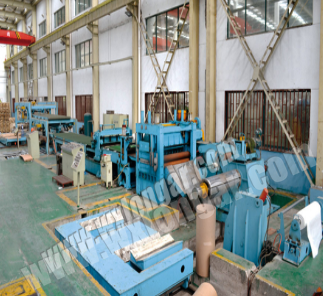
Working Principle And Control Process Of Rewinding Machine
2019-04-22 10:20 ┬Ā┬Āadmin
Here is Slitter Rewinder Machinery Manufacturer talking about Working principle and control process of rewinding machine.
If you have any idea about it, welcome to contact us and discuss.
Before the rewinding, the paper roll for the raw paper roll will be placed on the paper return table. The paper return frame is equipped with a brake motor (retraction roller motor) so that if the winder is running The occurrence of paper breaks can cause the winder to brake quickly. A rotary encoder is typically installed on the motor as speed feedback through a series of calculations in the PLC to maintain the web tension. During operation, the paper web is drawn from the paper take-up roller through the paper guide roller, the curved roller, the circular knife slitting portion, the paper guiding roller, the curved roller, the bottom roller, and finally wound on the paper core between the two bottom rollers; After the front and rear bottom rollers are rotated, the paper core is rotated by the frictional force generated by the two bottom rollers and the entire web is pulled to wind up the take-up portion. During the operation of the winder, the tension of the web stretches the web so that it is drawn from the original paper roll.

The paper web is wound onto the finished paper roll core as required so that the reminder can be prevented from breaking out at high speed.
Slitter Rewinder control process analysis:
To analyze the control process of the winder, it is first necessary to know the quality indicators required for the finished paper roll to the winder. The quality index of the rewinding machine control process is mainly reflected in the hardness of the finished paper roll (to meet the requirements of tightness and looseness inside), and the cross section of the finished paper roll (the cross-section of the round knife cutting paper should be flat, so that the finished paper roll can be released after the finished paper roll Reprocessing), the degree of wear of the coated white paper surface (the paper surface and the two bottom rollers should be in contact during the rewinding, the paper surface should not be excessively worn during the rewinding process), and the running speed of the rewinding machine (The speed of the base paper produced by the paper machine, the speed of the rewinding machine running is at least 3-5 times faster than the speed of the paper machine).
The hardness of the finished paper roll can be expressed by the density. According to the density definition, the weight of the finished paper roll is divided by its volume. If the density is large, the hardness of the paper roll is large; the tightness of the paper roll is to prevent the rewinding process. The paper roll is deformed as the volume increases, and the outer looseness is that the finished paper roll can maintain a certain elasticity during transportation to prevent damage; it is also required that the radial hardness of the finished paper roll is evenly distributed. In the process of cutting the paper web, the circular knife will inevitably form a slit section between the separated paper webs. In theory, it can be cut into a flat surface, but it is not easy to do in the actual process if the cutting is not smooth. This will cause the two separate finished paper rolls to be difficult to separate after rewinding. Coated whiteboard paper is a type of coated paper. The paper web has a shiny coating layer on one side, and the coated surface is in contact with the bottom roller during the rewinding process, so it cannot be excessively worn.
In the production process of the finished paper roll, the rewinding machine must stop every time the original paper roll is replaced, and under normal circumstances, a raw paper roll breaks during the rewinding process and may be divided into several times to be used up. The reel must stop to make joints or replace the finished paper core to start re-rolling. These intervals are usually inevitable, so to ensure the normal production of the finished paper roll, the rewinding machine must run faster than the rewinding machine. The speed of the entire paper machine is 3-5 times faster.
┬® 1994-2020 Wuxi Longar Machinery Manufacturer Co.,Ltd.
┬ĀAll Rights Reserved ┬Ā ┬ĀDesign by WxlonGar┬Ā┬Ā┬Ā┬Ā┬Ā┬Ā┬Ā┬Ā┬Ā┬Ā┬Ā┬Ā┬ĀPrivacy Policy

 Russian
Russian ń«ĆõĮōõĖŁµ¢ć
ń«ĆõĮōõĖŁµ¢ć











